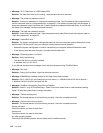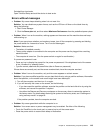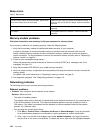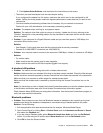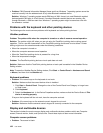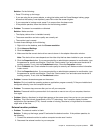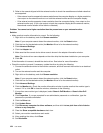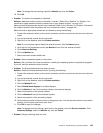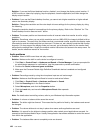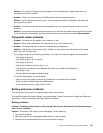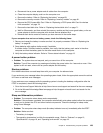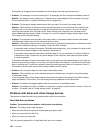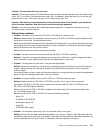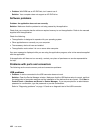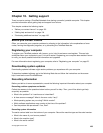
Solution: If you use the Extend desktop function, disable it, and change the display output location. If
a DVD movie or a video clip is playing, stop the playback, close the application, and then change the
display output location.
• Problem: If you use the Extend desktop function, you cannot set a higher resolution or higher refresh
rate on the secondary display.
Solution: Change the resolution and the color depth to lower settings for the primary display by doing
the following:
Change the resolution depth to lower settings for the primary display. Refer to the “Solution” for “The
Extend desktop function does not work” above.
• Problem: The screen position on the external monitor is incorrect when that monitor is set for a high
resolution.
Solution: Sometimes, when you use a high resolution such as 1600x1200, the image is shifted to left or
right on the screen. To correct this, rst make sure that your external monitor supports the display mode
(the resolution and the refresh rate) that you have set. If it does not, set a display mode that the monitor
supports. If it does support the display mode you have set, go to the setup menu for the monitor itself
and adjust the settings there. Usually the external monitor has buttons for access to the setup menu. For
details, see the reference manual for the monitor.
Audio problems
• Problem: Wave or MIDI sound does not play correctly.
Solution: Make sure the built-in audio device is congured correctly.
1. Click Start ➙ Control Panel ➙ Hardware and Sound ➙ Device Manager. If you are prompted for
an administrator password or conrmation, type the password or provide conrmation.
2. Double-click Sound, video and game controllers.
3. Make sure the Conexant Pebble High Denition SmartAudio device is enabled and congured
correctly.
• Problem: Recordings made by using the microphone input are not loud enough.
Solution: Make sure that Microphone Boost is turned on and set as follows:
1. Click Start ➙ Control Panel ➙ Hardware and Sound ➙ Sound.
2. Click the Recording tab in the Sound window.
3. Select Microphone, and click the Properties button.
4. Click the Levels tab, and move the Microphone Boost slider upwards.
5. Click OK.
Note: For details about controlling volume, refer to your Windows help information system.
• Problem: A volume or balance slider cannot be moved.
Solution: The slider might be dimmed. This means that its position is xed by the hardware and cannot
be changed.
• Problem: The volume sliders do not stay in place when some audio applications are used.
Solution: It is normal for the sliders to change position when certain sound applications are used. An
example is the Windows Media Player. Usually the application has sliders available to control the sound
from within the application.
• Problem: The balance slider cannot completely mute one channel.
126 User Guide



